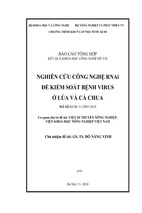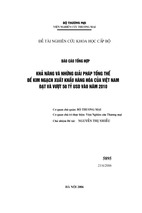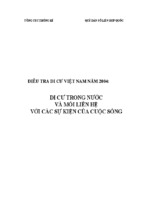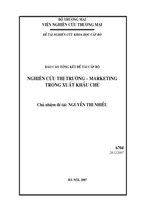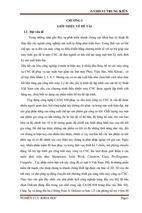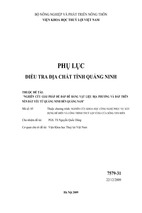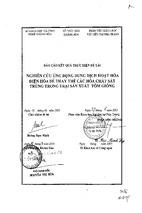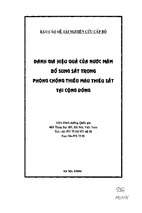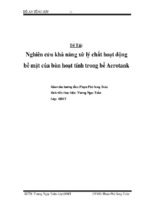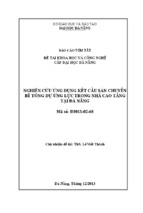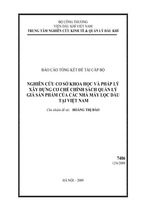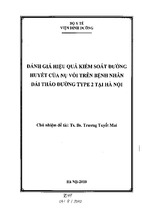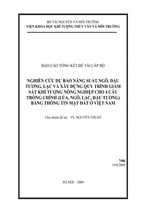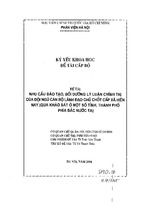Vietnam in the Global Economy
Development through Integration
or Middle-income Trap?
Hansjörg Herr, Erwin Schweisshelm, Truong-Minh Vu
Vietnam is at the lowest end of global value chains in industrial
productions and, at the same time, depends on the export of
natural resources. Market mechanisms are reproducing this type
of underdevelopment.
The era of free trade after the 1980s did not bring higher
worldwide growth than the first decades after World War II with
more regulated trade and capital controls. Overall, Vietnam is well
advised to be cautious in its growth and employment expectations
of the TPP and other FTAs.
Vietnam needs to build economic clusters with forward and
backward linkages to exploit economies of scale and scope, as
well as synergies and positive external effects. Big companies
including state-owned enterprises have to build up networks of
domestic suppliers to increase their local content.
A comprehensive industrial policy, which is poor at present in
Vietnam, is needed. Vietnam especially lacks institutions that are
able to select, implement, evaluate, and modify industrial policy
when needed.
Contents
List of Abbreviations
i
Foreword ii
Introduction 1
Integration of developing countries into the world market and economic development
3
Traditional economic trade models and economic development
3
GVCs and economic development
9
The danger of the MIT
15
Vietnam’s integration into the global economy
Overview of Vietnam’s integration into the global economy
Structure of exports and imports in Vietnam
GVCs in industrial productions
Effects of FTAs
17
17
18
22
25
The role of industrial policy for development
Principles of industrial policy
The role of the exchange rate
Overview of Vietnam’s industrial policy
29
29
31
33
Recommendations for Vietnam
36
Notes 41
Bibliography 43
List of Abbreviations
MIT
OECD
RMG
R&D
SOE
SEDS
TPP
UNCTAD
US
VEIA
VITAS
WTO
AFTA
ASEAN Free Trade Agreement
ASEAN
Association of Southeast Asian Nations
EPA
Economic Partnership Agreement
CIEM
Central Institute for Economic
Management
CMT
Cut, Make, Trim
CPV
Communist Party of Vietnam
EU
European Union
FDI
Foreign Direct Investment
FOB
Free On Board (finished product sourcing)
FTA
Free Trade Agreement
GDP
Gross Domestic Product
GVC
Global Value Chain
ILO
International Labour Organization
IMF
International Monetary Fund
LEFASO
Association of Vietnamese Footwear,
Leather and Bag Producers
i
Middle-Income Trap
Organisation for Economic Co-operation
and Development
Ready-Made Garments
Research and Development
State-owned Enterprise
Socio-economic Development Strategy
Trans-Pacific Partnership Agreement
United Nations Conference on Trade
and Development
United States
Electronic Industries Association
of Vietnam
Vietnamese Textile and
Apparel Association
World Trade Organization
Foreword
The multiple crises crippling our societies – from climate
change to financial meltdown, from rising inequality to
mass migration – are shaking the foundation of the world
order. Taken together, these crises go well beyond the
policy level, but call into question the very paradigms that
the foundation of our economies are built around.
middle-income country, the focus of the EoT project in
Bangladesh is on economic growths and decent work as
well as institutional reforms for development.
In Thailand, resilient fiscal policy is the focus of the EoT
network. After its founding in 2016, a Policy Community
on Taxation Reform will continue to promote taxation
policy as well as look into the spending to identify needs
and perspectives in the context of upcoming challenges of
an aging society.
In 2011, economic thinkers and political decision-makers
from China, Germany, India, Indonesia, Korea, Poland,
Sweden, Thailand and Vietnam came together to discuss
how our development models need to be adapted. Later
joined by Bangladeshis, Filipinos, Malaysians, Pakistanis
and Singaporeans, several regional dialogues discussed
how to reconcile growth and equity, find a balance
between boom and bust cycles, and how to promote
green growth and green jobs. The findings, endorsed
by 50 prominent thought leaders from Asia and Europe,
have been published as “The Economy of Tomorrow.
How to produce socially just, resilient and green
dynamic growth for a Good Society”(versions available
in English - 5th edition, Bahasa, Korean, Mandarin, Thai
and Vietnamese, at designated page for Economy of
Tomorrow, www.fes-asia.org.) The EoT Manifesto calls
for an inclusive, balanced and sustainable development
model which can provide the conditions for a Good
Society with full capabilities for all.
Supporting the phase-out of a resource-driven and
therefore extractive economic model, while strengthening
the promotion of a sustainable manufacturing sector as
well as the maritime and digital economy are the main
efforts in Indonesia.
Vietnam is putting emphasis on an export-oriented,
FDI-driven development strategy, focusing on wageled growth models, productivity gains and value chain
improvement to find a way out of the middle income trap.
The EoT project in China focusses on the socioeconomic consequences of innovation-driven changes
in the manufacturing and service sectors, and explores
how China can achieve growth while implementing a
sustainable climate and energy policy.
True to our understanding that development models
need to be tailor-made, in the second phase of the
project national EoT caucuses have worked on adapting
these sketches to the local context. At the regional level,
the focus was on the political and social challenges
which needed to be addressed to encourage qualitative
economic growth. The national studies carried out on the
political economy of development as well as the synthesis
“Mind the Transformation Trap: Laying the Political
Foundation for Sustainable Development” are available
on the website.
In Pakistan the current focus is on institutionalising the EoT
discourse by bringing together governmental and nongovernmental think tanks as wells as leading individuals
to develop a common advocacy agenda. A comprehensive
compilation of previous research work will serve as a
blueprint for political discussions during the upcoming
election campaign.
Erwin Schweisshelm,
Resident Representative, FES Vietnam Office
In the third phase, the EoT project will focus on specific
sectors of transformation. In India, for example, the focus
is on energy transformation, urbanization and digital
transformation. After graduating to the status of a low
Marc Saxer,
Regional Coordinator, “Economy of Tomorrow”
September 2016
ii
Introduction
Introduction
In the mid-1980s at the start of the Đổi
Mới (renovation), Vietnam was a backward
agricultural country under a socialist economic
system, based on the centrally directed
allocation of resources through administrative
means. At that time, most of the workforce
was involved in agricultural production, but
the country faced food shortages and had
to import rice. Industry was weak and faced
poor productivity. The overwhelming majority
of the population was deeply stuck in poverty.
Vietnam’s approach to economic reform has
been characterised by two main features.
Firstly, it followed a top-down and step-bystep approach. Pilot projects in some localities
were carried out on an experimental basis
before they were applied to the whole country.
Secondly, there was a consensus among the
Vietnamese leadership not to combine marketoriented reforms with political liberalisation.
In addition, the important role of state-owned
enterprises (SOEs) was maintained during the
introduction of market-oriented reforms.
Since the beginning of the process of Đổi
Mới, economic growth in Vietnam has
been remarkable. Between 1991 and 2009,
Vietnam’s real gross domestic product (GDP)
grew with an average growth rate of 7.4
percent. In 1990, Vietnam’s GDP per capita
of US$98 placed Vietnam among the poorest
countries in the world. In 2009, its GDP
per capita of US$1,109 led to Vietnam’s
attainment of lower middle-income status,
according to the World Bank classification
methodology. In 2014, Vietnam’s GDP per
capita reached US$2,052 (Haughton et
al., 2001; Quan, 2014). Economic reforms
resulted in Vietnam’s increased integration
into the global economy. This integration
process is still underway with Vietnam’s trade
commitments under ASEAN, its accession to
the World Trade Organization (WTO) in 2007,
and Vietnam’s signing of the Trans-Pacific
Partnership Agreement (TPP) in 2015.
The question remains as to whether this
spectacular development will be able to
continue. There are a number of experts who
believe that Vietnam is in danger of falling
into the middle-income trap (MIT) or might
already be affected by it (Pincus, 2015; Ohno,
2015). The MIT implies that the convergence
between a developing country and the most
developed countries in the world does not
become smaller as the developing country is
stuck at a certain level of per capita income.
The only sustainable way to overcome the MIT
and join the group of developed countries is
to increase the productivity and innovative
power of a country. If developing countries are
unable to catch up to the level of productivity
of developed countries, a conversion of the
living standards between developing and
developed countries will not be possible.
However, productivity increases are not
the only factor for economic development.
Besides productivity development, an inclusive
growth model with not too high income
inequality and a functioning financial system
delivering sufficient credit with low interest
rates are also preconditions for sustainable
development.
The aim of this paper is to analyse the specific
way in which Vietnam has been integrating
into the global economy and what kind
of production structure has been created
in Vietnam as a result. The key question is
whether the type of integration (being carried
out by Vietnam) into the world market is
supporting economic development in Vietnam
via an increased the productivity level or not.
It will be asked what kind of integration
different economic approaches expect. This
paper will then determine to what extent the
different theoretical approaches are able to
explain development in Vietnam and whether
Vietnam is in danger of getting stuck in the
MIT.
1
Vietnam in the global economy: development through integration or middle income trap?
The main conclusion of this paper is that
theoretical considerations and empirical
analyses support the hypothesis that an
unregulated integration in the world market
is not beneficial for Vietnam in the long run
and could lead to Vietnam becoming stuck in
the MIT. Integration into the word market is
of key importance for a country like Vietnam,
but it needs to be guided by a comprehensive
industrial policy and government intervention.
To leave the integration of Vietnam completely
to the market leads to the reproduction of
underdevelopment. A combination of market
and government activities is needed to reach
a sustainable level in order for developing
countries to catch up.
The second section of this paper will give
a review of the most important traditional
economic models to explain international
distribution of labour. From the perspective
of a developing country, the analysis looks
at what kind of industrial development these
models predict for a country like Vietnam. The
2
section also concentrates on a phenomenon
that gained paramount importance over the
last three decades – global value chains (GVCs)
and offshoring. It will be asked to what extent
GVCs increase the chances of economic
development for countries like Vietnam.
The third section analyses in detail how
Vietnam has integrated into the global
economy. The theoretical approaches from
section two will be used to understand
Vietnam’s role in the international distribution
of labour. Import and export structures will
be analysed, as well as the role of GVCs in
Vietnam. The theoretical prediction will be
largely supported by the empirical analysis.
Without government intervention, the MIT is
a serious danger for Vietnam.
The fourth section draws policy conclusions
for Vietnam. Here, industrial policy and its
adaptation to the situation in Vietnam will be
discussed.
Integration of developing countries into the world market and economic development
Integration of developing countries into
the world market and economic development
Traditional economic trade models and
economic development
We will start with the model of absolute
advantages and then analyse comparative
advantages, as well as different factor
endowments. These trade models assume
that goods are traded as complete goods.
This implies that the production process of a
good is not divided into different tasks, which
are produced in different countries through
GVCs. To understand the logic of trade,
usually in these models mobility of capital
is assumed to be zero, which automatically
implies a balanced current account. Finally,
these models assume constant returns to
scale and competitive markets.
Absolute advantages
The most simple and obvious model to
explain international trade is the model of
absolute advantages. Adam Smith (1776)
argued that in the case of one country being
good at producing one thing, and another
country being good at producing another
thing, the welfare of both countries could be
increased by trade. Absolute advantages are
based on different technological levels and/or
different natural conditions which influence
productivity.
For example, if Vietnam has higher
productivity in textile production and the
United States (US) is more productive in car
production, to increase the welfare of both
countries, Vietnam should concentrate on
the production of textiles and the US should
focus on making cars. Table 1 shows the
logic behind, and consequences of this type
of trade. It is assumed that the US has an
absolute advantage in producing cars – it
needs 10 units of labour1 to produce a car,
whereas Vietnam needs 40 units of labour
to produce a car. Vietnam has an absolute
advantage in producing textiles. For a given
quantity of textiles, Vietnam needs 20 units
of labour, whereas the US needs 35 units.
Without international trade, the production
and consumption of the assumed quantities
of textiles and cars need a total sum of 105
units of labour in both countries. If each of
the countries concentrates on the goods
with its absolute advantage and produces
twice as much as before and exchanges cars
against textiles, the level of consumption in
both countries will stay the same, whereas
the needed hours for producing the goods
can be reduced to 60 hours altogether. The
conclusion made by Adam Smith was that
international trade (similar to national trade)
increases the wealth of nations and markets,
and leads to specialisation according to
absolute advantages.
Some assumptions are made to come to
the welfare conclusion drawn by Smith. The
most important one is that there is sufficient
demand so that world output increases and
the production factors that have become
unused as a result of efficiency gains will be
able to be employed.2 If the 45 units of saved
labour in our example become unemployed,
the wealth of a nation will not necessarily
increase. From a Keynesian perspective
there is no guarantee that a switch to more
free trade increases aggregate demand
and output. If Say’s law, which assumes
that supply creates its own demand, does
not hold, free trade can lead to permanent
higher unemployment. It is sometimes argued
(mainly by non-economists) that free trade
increases the surplus in the trade balance (or
reduces a deficit) and positive employment
effects can be expected. However, a switch to
free trade has nothing to do with surpluses
or deficits in the trade and current account
balances. Only in a world of lunatics can free
trade lead to current account surpluses in all
countries. Secondly, it has to be assumed that
3
Vietnam in the global economy: development through integration or middle income trap?
When we look
at the areas
where countries
like Vietnam
have absolute
advantages, we
quickly detect
the importance
of unprocessed
agricultural
products and
natural resources.
the factors of production move smoothly from
one industry to another one. In a concrete
economic constellation, such structural
changes can become difficult for countries.
In our example, American textile workers may
not be qualified to become workers in the
car industry. Finally, the model does not show
which of the two countries would achieve the
biggest welfare gains. Even if it increases the
welfare of both nations, trade can produce
some losers in both countries.
In the context of this paper, the most important
question is how productivities change when
countries integrate into the global economy.
Productivity is defined as output per unit
of labour. In our exemplification in Table 1,
the productivities of producing a car and
a given quantity of textiles are calculated.3
To calculate average productivity, each of
the productions is weighed according to
the labour needed in the industry.4 The
productivity gap for the whole of Vietnam’s
economy before international trade is 0.006.
Productivity in Vietnam under the condition
of international trade increases because the
country concentrates on the production of the
good with its absolute advantage, which has a
productivity of 0.05. In addition, productivity
in the US increases at an even faster rate, and
the productivity gap in Vietnam increases
to 0.05. The explanation for this is that the
absolute advantage in producing cars is bigger
than the absolute advantage of Vietnam in
producing textiles. The figures in Table 1 are
not based on empirical facts. However, the
constellation shown in the table might not be
unrealistic for many goods in a country like
Vietnam.
When we look at the areas where countries
like Vietnam have absolute advantages, we
quickly detect the importance of unprocessed
agricultural products and natural resources.
Examples of the first group of goods are
coffee beans, rice, sugar cane, or fish.
Examples of the second group of goods are
coal, manganese, bauxite, chromate, offshore
oil, or natural gas. Such absolute advantages
can result from natural conditions, such as
the climate or locations of rare earths. The
possession of such natural advantages is not
necessarily a blessing for countries. While it
can allow the earning of hard currency in a
relatively easy way, empirically, most countries
with these advantages have not developed
in a sound way. There are good theoretical
explanations for this.
Table 1: International trade with absolute advantages
Before trade
After trade
Vietnam
Vietnam
Units of labour needed
per given quantity of good
US
Total hours
US
Total hours
Units of labour needed
Cars 40 10 2x10=20
Textiles
20
35
2x20=40
Total hours
60
45
105
40
Productivities
without trade*
Productivity
gap Vietnam**
Productivities
with trade*
Cars
1:40=0.025 1:10=0.100
Textiles
1:20=0.050 1:35=0.029
Average
(0.66·0.025)
(0.22·0.100)
0.006
productivity*** +(0.33·0.050) +(0.78·0.029)
= 0.033
= 0.039
60
Productivity
gap Vietnam**
2:20=0.100
2:40=0.050
0.050
*Quantities produced per labour input, **US productivity minus Vietnamese productivity,
***Each industry is weighted according to its labour input in relation to total labour input
4
20
0.100
0.050
Integration of developing countries into the world market and economic development
Hans Singer (1950) and Raúl Prebisch (1950)
argued that the producing and exporting
natural resources, including basic agricultural
products by countries, would lead to a
deterioration of the terms of trade in these
countries in the long-term. In the long-term,
this means that developing countries that
concentrate on the production of natural
resources have to exchange more and more of
their primary products against the industrially
produced products of developed countries.
Explanations for this effect are manifold.
Productivity growth in industrial productions
might be higher than in the production of
agricultural products and natural resources
extraction. In addition, the price elasticity of
primary goods for single suppliers is higher
than for industrial products. For example,
exporters of coffee beans or oil produce
a relatively homogenous good and are
confronted with competition from exporters
in many countries. Firms in developed
countries exporting new high-tech or lifestyle
products can exploit monopolistic positions
and avoid price competition. Also, the income
elasticity of primary goods is supposed to
be lower than for industrial products. The
long-term terms of trade effect expected by
Singer and Prebisch reflects an overall slower
productivity growth in developing countries
producing natural resources, as well as a
relative stagnation of the demand of such
products. By allowing the market mechanism
to work, developing countries will be pushed
towards the production and export of primary
products with relatively low value-added. This
reduces the possibility of developing countries
catching up to more developed countries.
Empirically the Prebisch–Singer terms of
trade hypothesis is supported for most of the
primary products. However, there are some
exceptions (Harvey et al., 2010; Arezki et al.,
2013).
The Prebisch–Singer hypothesis seems not to
hold for some natural resources, for example,
for crude oil and rare earths. These resources
seem to follow a trend of long-term increasing
prices based on natural scarcity. In the long
run, the price of these natural resources may
increase because the production costs to
extract or mine them increase with depletion.
However, presently and for an uncertain time
into the future, prices of natural resources are
above production costs and prices are based
on oligopolistic market structures. To what
extent such oligopolies are able to increase
prices and keep them high is an open question,
given the fierce competition of natural
resource producers to export their natural
resources.5 The development of oil prices after
2008 is a good example of this. However,
even when prices of natural resources are
high and high rents can be earned possessing
and exporting natural resources, they are still,
for many countries, a double-edged sword.
The problem is that a country that exports
natural resources as a high percentage of its
total exports will import a high percentage
of its consumption and capital goods. Thus,
a country focusing on the export of natural
resources will make its industrial sector suffer.
This phenomenon is known as Dutch disease.
When in the 1960s the Netherlands found
offshore oil, the domestic industrial sector
found itself in crisis. The global demand for
Dutch oil led to an appreciation of the Dutch
guilder and reduced the competitiveness of
the Dutch industry. As a result, this reduced
the dynamic of the Dutch economy. Natural
resource rich countries are in danger suffering
from serious overvaluation, especially when
the industrial sector is taken as a benchmark.
The result of such an overvaluation is a lack
of competitiveness of the industrial sector
(Corden, 1984; Corden / Neary, 1982). The
problem is that the industrial sector has
a much higher potential for productivity
increases and innovation than the natural
resource sector. The outcome is that natural
resource rich countries suffer from a lack of
domestic economic dynamic and transform
into rent economies.
The reliance on natural resource exports leads
to other serious potential negative effects.
5
The possession
of such natural
advantages is
not necessarily
a blessing for
countries.
By allowing
the market
mechanism to
work, developing
countries will be
pushed towards
the production
and export of
primary products
with relatively
low value-added.
This reduces
the possibility
of developing
countries
catching up to
more developed
countries.
Vietnam in the global economy: development through integration or middle income trap?
Natural resource
prices and natural
resource exports
show a high
volatility and
expose natural
resource-exporting
countries to large
shocks.
Natural resource prices and natural resource
exports show a high volatility and expose
natural resource-exporting countries to large
shocks. In many cases, government revenues
depend to a large extent on the development
of the natural resource sector. In such cases,
the volatility of natural resource exports has
even bigger negative effects as it distorts the
functioning of public households. Lastly, in
many cases, natural resource rich countries
show a high level of corruption and a low level
of democracy as the incentives for powerful
groups in society to grab some of the natural
resource rents are high (Humphreys / Sachs /
Stiglitz, 2007). Good institutions are needed
to overcome negative effects of Dutch disease.
Although an exception, Norway serves as a
good example for good institutions and the
avoidance of Dutch disease.
The question for Vietnam is: does the export
of goods with low terms of trade (for example,
coffee and rice) and of natural resources (for
example, crude oil) with the danger of Dutch
disease play an important role? These goods
play a role in Vietnam’s exports and some
negative effects must be expected.
Comparative
advantages
and
factor
endowments
One of the most important arguments of
free trade goes back to David Ricardo (1817)
and his model of comparative advantages.
International institutions like the WTO or
the International Monetary Fund (IMF) and
many governments still follow different
versions of Ricardo’s approach today. Ricardo
assumed different productivity levels in
different countries. In contrast to Adam
Smith, he asked whether international trade
made sense, under the condition that one
country is less productive in all industries. This
assumption very much fits the constellation
of countries like Vietnam, which are with
regard to industrial production characterised
by a general low level of technological
development compared to developed
countries. The not-so-obvious answer given
6
by Ricardo is that even under such conditions,
international trade is welfare-increasing for
all countries. If countries concentrate on the
production of products they are relatively
good at producing in the same output in the
world, these products can be produced with
less input of labour (and other inputs). For a
country like Vietnam, this implies the export
of goods where the productivity difference
(compared to developed countries) is the
lowest, and the import of goods where the
productivity difference is the highest. Indeed,
the market mechanism leads to this structure
of trade.
To reveal the consequences of this type of
trade, the numerical example in Table 1 is
modified. In Table 2 we assume, as in Table
1, that Vietnam and the US both produce
textiles and cars. But now the US economy
is better at producing all goods. To produce
one car the US needs 20 labour units, while
to produce a given quantity of textiles it
needs 40 labour units. The not-so-efficient
Vietnamese economy needs 40 labour units
to produce one car and 50 labour units to
produce a given quantity of textiles. If both
countries produce both goods and there is no
international trade, both countries together
need 150 hours to produce the given quantity
of cars and textiles. In the US, the productivity
advantage in the car industry is bigger than
in the textile industry. For Vietnam, the
disadvantage of producing textiles is relatively
small. Thus, with international trade, Vietnam
will produce textiles and the US will produce
cars – an example with high plausibility. With
international trade, the same quantity of
goods can be produced with 140 labour units.
Ten units can be saved. Of course, as in the
example with absolute advantages, a set of
conditions must be satisfied to realise positive
welfare effects.
Before international trade, the average
productivity level of Vietnam (0.022) is below
the US level (0.033) and the productivity gap
between the US and Vietnam is 0.011. The
Integration of developing countries into the world market and economic development
Table 2: International trade with comparative advantages
Before trade
After trade
Vietnam
Total hours
Hours needed per given
quantity of good
US
Vietnam
US
Total hours
Units of
labour needed
Cars 40 20 2x20=40
Textiles
50
40
2x50=100
Total hours
90
60
100
Productivities
without trade*
Cars
1:40=0.025 1:20=0.050
Textiles
1:50=0.020
1:40=0.025
2:100=0.020
Average
productivity***
(0.44·0.025)
+(0.56·0.020)
= 0.022
(0.33·0.050)
+(0.67·0.025)
= 0.033
0.020
150
40
Productivity
Productivities
gap Vietnam** with trade*
0.011
140
Productivity
gap Vietnam**
2:40=0.050
0.050
0.030
*Quantities produced per labour input, **US productivity minus Vietnamese productivity,
***Each industry is weighted according to its labour input in relation to total labour input
important point is that now, in the logic of
comparative advantages, international trade
reduces the productivity level of Vietnam and
increases the productivity gap with the US.
Table 2 shows that trade reduces average
productivity in Vietnam to 0.020 and the
Vietnamese productivity gap widens to 0.030.
This should not be a big surprise as Vietnam
gives up the more demanding and advanced
car industry and concentrates on the less
productive textile industry. International trade
leads to the breakdown of the car industry in
Vietnam and Vietnam specialises in textiles –
an overall low-tech and low-productivity good.
In the US, the textile industry disappears and
the country concentrates on the production
of cars – a high-tech product.
The Prebisch–Singer hypothesis takes a new
and more radical form. Under the condition
of different productivity levels of countries,
unregulated international trade pushes
developing countries to produce relatively
low-tech and low value-adding products, and
concentrates high-tech and high value-adding
productions in developed countries. Under a
static approach, Ricardo’s argument is correct
– international trade between counties with
different levels of development increases
the efficiency of worldwide production. The
welfare of consumers will increase, at least in
the short term.
Under a dynamic perspective for a developing
country, the market determined distribution
of international labour implies a huge
disadvantage. As it is pushed to concentrate
on low-tech, labour-intensive, low-skilled
productions, it will have a lower chance of
developing. Friedrich List was very critical
about free trade between countries with
different levels of development. He argued
against England, which developed under
protectionism and then preached free trade:
“Any nation which by means of protective
duties and restrictive navigations has raised
her manufacturing power and her navigation
to such a degree of development that no
other nation can sustain free competition with
her, can do nothing wiser than to throw away
these ladders of her greatness, to preach to
other nations the benefits of free trade, and to
declare in penitent tones that she has hitherto
wandered in the path of error, and has now
for the first time succeeded in discovering
the truth.” (List, 1855: 295f.) Indeed, HaJoon Chang (2002) shows that virtually all
developed countries nowadays, including the
United Kingdom and the US, used industrial
policy to protect and support their industries
in their developmental phase.6 It is worthwhile
listening to Joan Robinson, who made the
same argument (1979: 103): “The most
misleading feature of the classical case for
7
Vietnam in the global economy: development through integration or middle income trap?
Countries concentrating
on high-tech, high-skilled
productions including
services, will gain from
learning-by-doing, by
developing a high-skilled
workforce, benefitting
from positive synergies,
carrying out more
firm-based research,
and so on.
Free trade will not
help to overcome
the disadvantages of
developing countries;
rather, it will add
to their problems.
free trade […] is that it is purely static. It is set
out in terms of a comparison of productivity
of given resources [fully employed] with or
without trade. Ricardo took the example of
trade between England and Portugal. […] It
implies that Portugal will gain from specialising
on wine and importing cloth. In reality, the
imposition of free trade on Portugal killed off
a promising textile industry and left her with
a slow-growing export market for wine, while
for England, exports of cotton cloth led to
accumulation, mechanisation and the whole
spiralling growth of the industrial revolution.”
List’s and Robinson’s argument is valid still
today. Countries concentrating on hightech, high-skilled productions including
services, will gain from learning-by-doing,
by developing a high-skilled workforce,
benefitting from positive synergies, carrying
out more firm-based research, and so on.
Such countries can build up monopolistic
or oligopolistic constellations of their firms
based on technological superiority and can
earn high quasi-technological rents. The
high profits of these firms will further spur
innovation and investment in research and
development (R&D). Developed countries
with a concentration of high-tech, high-skilled
productions will benefit from the positive
external effects of markets, as Alfred Marshall
(1890) called it, and from the concentration of
industrial high-tech productions and services
(Krugman, 1991). These processes unfold a
strong path-dependency, making innovative
countries endogenously more innovative.
These advantages do not exist in developing
countries, or exist to a much smaller extent.
Free trade will not help to overcome the
disadvantages of developing countries; rather,
it will add to their problems. This is why
Joseph Stiglitz (2006) demanded a one-sided
protection of developing countries via tariffs
and other instruments to make international
trade fair. He also favoured the transfer of
certain patents to developing countries for
free or a low price.
8
This does not mean that countries in
their first development phase should not
concentrate on low-tech, labour-intensive
production. They can do so when they enter
mass production and exploit economies of
scale. Such mass productions will trigger
productivity increases through specialisation
and learning effects. However, they should
support domestic forward and backward
linkages of mass productions. The positive
effects of mass productions need to be
supported by industrial policy in order for the
country to enter into new and more valueadding industries. Industrial policy is needed
at any stage of development; at any stage
of development new industries need to be
created and the private sector is not able to
develop such industries alone.
According to mainstream thinking in the
tradition of David Ricardo, international trade
should lead to the specialisation of countries
as an element of positive development.
However, this recommendation does not
fit the empirical development of successful
developing countries. Jean Imbs and Romain
Wacziarg (2003: 64) found in a broad empirical
analysis that successful developing countries
“diversify most of their development path”.
Obviously only a broad spectrum of industries
is able to create synergies between different
industries and increases the likelihood and
possibilities of entrepreneurship. Development
has a lot to do with random self-discovery,
which cannot be explained by specialisation
according to comparative advantages (Rodrik,
2004).
The Smith-Ricardo model has a great
explanatory power for the explanation of
the international distribution of labour. If
countries introduce free trade and the market
is allowed to work freely, the outcomes are as
follows: developing countries will concentrate
on low-tech, low-skilled productions and
developed countries will concentrate on hightech, high-skilled productions. Below it will be
shown that Vietnam fits into this first scenario.
Integration of developing countries into the world market and economic development
The
factor-endowment
argument
for
international trade
Eli Heckscher (1919) and Bertil Ohlin (1933)
assumed the same technological knowledge
in all countries in the world but different factor
endowments.7 The typical developing country
has a high stock of labour and not much
capital, while the typical developed country
has a high stock of capital goods in relation to
labour. The specialisation rule in international
trade is that countries should concentrate on
productions which especially need the relative
abundant production factor. Developing
countries should concentrate on labourintensive productions because this is the area
of their comparative advantage. Developed
countries should therefore concentrate on
capital-intensive productions. International
trade will, as in the Smith-Ricardo model,
increase the efficiency of world production and
will (sufficient aggregate demand assumed,
etc.), increase the welfare of countries.
The Heckscher-Ohlin model is less important
for our question. There are not many
industries in developing countries that
possess the same technological knowledge
and possibilities as industries in developed
countries. Even if knowledge is free, it is
often difficult to transfer to developing
countries. There is a lack of skills; and the
experience to use advanced knowledge does
not exist. The Heckscher-Ohlin model defines
the development problem by assuming that
developing countries have the same skill and
technology level as developed countries.
Wassily Leontief (1954) found in his empirical
investigation that US international trade does
not follow the prediction of the HeckscherOhlin model. Later, this so-called Leontief
paradox was found in many other countries.
The main explanation for the paradox can
be found in the fact that technological
knowledge, including differences in skill levels,
between countries are of key importance for
international trade and are not captured by
the model.8
GVCs and economic development
The vision of the old trade models, with trade
of goods produced in one industry exchanged
against goods of another industry, no longer
reflects reality.9 In 2013, trade in intermediate
goods had the biggest share in world trade,
reaching US$7 trillion, followed by primary
goods with US$4 trillion, consumer goods
with US$3.8 trillion, and capital goods
with US$2.7 trillion. Almost 50 percent of
intermediate goods come from developing
countries (UNCTAD, 2014). What we find is
the dominance of international trade within
one industry in intermediate goods, to a
large extent within multinational companies
or controlled by multinational companies.
Alan Blinder (2005) describes the increasing
role of offshored productions in GVCs within
an industry as a new industrial revolution.
Indeed, a new dimension of globalisation
started to develop during the 1990s due to the
revolution in information and communication
technology, the reduction of transportation
costs, and the implementation of the
Washington Consensus policies in developed
and developing countries – which deregulated
international trade and capital flows.
These developments allowed multinational
companies in particular to break down their
production processes into different stages and
outsource these stages to other companies,
which in many cases were in other countries.
Below it will be shown that Vietnam is also
intensively integrated in GVCs.
Trade effect of GVCs
In the case of GVCs, the production process
is cut into different tasks; different companies
all over the world fulfil these tasks. Analytically
the different tasks become their own
products. The international allocation of the
production of these different tasks depends
to a large extent on comparative advantages.
Thus, the old trade models can be applied to
GVCs (Feenstra, 2010). However, the new
trade theory added to the understanding of
GVCs (Krugman, 1979; 1991). Most industrial
productions are characterised by economies
9
Only a broad
spectrum of
industries is able
to create synergies
between different
industries and
increases the
likelihood and
possibilities of
entrepreneurship.
Vietnam in the global economy: development through integration or middle income trap?
The argument
of economies of
scale and scope
also makes clear
that first-mover
advantages
exist with high
entry barriers for
latecomers.
GVCs are
characterised by
the rent-seeking of
leading firms and
brutal competition
between suppliers
at the lower end of
the value chain.
of scale and scope, which are based on
for example, indivisibilities (in research,
marketing, branding, etc. or using the same
engine or other parts in different cars of a
company); on production clusters, which
create synergies and positive external effects
(concentration of high-tech companies in
one region); or on positive network effects.
As soon as economies of scale and scope are
allowed in economic models, the assumption
of pure competition breaks down. Oligopoly
and monopoly competition becomes the
norm and with it rent-seeking in the form of
technological rents, branding, or asymmetric
power relationships between firms. As soon
as a country manages to host domesticallyowned firms that are in a global oligopolistic
and monopolistic position, these firms will
increase domestic income via rent-seeking
(more than normal profits) at the cost of
other countries. Strategic trade policy to
support domestic firms to achieve dominant
positions becomes rational. The argument
of economies of scale and scope also makes
clear that first-mover advantages exist with
high entry barriers for latecomers.
The complex production processes in GVCs are
managed by lead firms, in the first place by the
headquarters of multinational companies. Of
course in the hierarchical structure of GVCs,
headquarters of fashion firms, global retailers,
or car and electronics manufactures usually
do not directly interact with the lowest levels
of value chains. Big contract manufacturers
like Foxconn and Quanta (in the electronics
sector) or Puo Chen (in the shoe production
sector) are located on an intermediate level
of supply chains. Lead firms and big contract
manufacturers are obviously in a dominant
position as they structure the production
process and its location. They decide which
tasks remain in the headquarters and which
tasks are outsourced, in which countries,
and by which companies. In GVCs, there
is not the cosy world of international trade
between independent and equally strong
10
firms as in traditional trade models. GVCs
are characterised by the rent-seeking of
leading firms and brutal competition between
suppliers at the lower end of the value
chain. Monopsony structures dominate the
interaction between GVCs, at least in a typical
developing country.10
In the case of buyer-driven value chains,
the leading firm focuses on designing and
marketing functions while the manufacturing
process is completely outsourced as a rule to
legally independent subcontractors producing
under strict specification of the buyer (Gereffi,
1999). Typical cases of these types of GVCs
are labour intensive industries such as the
apparel and footwear industry, but also the
assembly of parts in the production process
of mobile phones or simple electronic
equipment. Producer-driven supply chains
are typically driven by lead firms, where
technology or high standards in production
play a more important role. Examples are
the production of automobiles, computers,
and heavy machinery. Lead firms in producerdriven value chains coordinate a complex
transnational network of production with
subsidiaries, subcontractors, and R&D units
where the assembly lines of the final good
typically remain under direct control of the
lead firm (Figure 1).
Another similar model of GVCs has been
designed by Baldwin and Venables (2013).
They distinguish between “spiders” and
“snakes”. In snake value chains, production
stages follow an engineering order, which
means each location fulfils one task and then
the (un-finished) product moves on to the
next location for new tasks and values to be
added. The chain continues until the product
is completely produced. In spider chains, the
production of a good does not follow any
particular order. Productions of tasks take
place at different (international) locations and
the final good is assembled in one location.
Integration of developing countries into the world market and economic development
Figure 1: Producer-driven and buyer-driven GVCs
Producer-driven chain
Manufacturers
Distributors
Retailers and dealers
Domestic and foreign subsidiaries
and subcontractors
Buyer-driven chain
Traders
Retailer and branded manufacturers
Overseas buyers
Factories (overseas)
Source: Adopted from Gereffi (1999), author’s illustration
GVCs can also be classified into horizontal
and vertical value chains. In horizontal value
chains, lead firms buy from other firms or
produce high quality inputs in subsidiary
companies. These types of suppliers are
typically highly specialised and have a high
technological standard. For example, Airbus
outsources the production of engines to
Rolls Royce. The motivation of this type of
value chain is to increase the quality of the
product and use the cost advantage of hightech specialisation. Vertical value chains’ main
motivation is to reduce production costs.
Tasks are outsourced to low-cost producers.
Following the logic of traditional international
trade theory, developing countries have a
comparative advantage in low-productivity,
low-skill, low value-adding tasks. Developed
countries, with their higher level of
technological standard and higher skill-levels,
have a comparative advantage in taking
over high-productivity, high-skill, high valueadding tasks. Developing countries are mainly
integrated in vertical value chains and the
main motivation to shift tasks to developing
countries is to make the final product cheaper.
A second motivation of offshoring is to gain
higher flexibility for lead firms. In case of
volatility in demand for final products, the
needed adjustment of production can be
shifted to lower levels of the value chain.
Just-in-time production allows higher levels
of the value chain to minimise inventories.
In this paper, we concentrate on the analysis
of vertical value chains, which are mainly of
importance for countries like Vietnam.
Vertical value chains dominate the
concentration of low value-adding and lowproductivity activities in developing countries
and the intensive competition at the lower
end of value chains, which allows only
low profits of suppliers. This phenomenon
can be expressed in what is known as the
“smile curve”, but should better be called
the “exploitation curve”.11 Figure 2 shows
the exploitation curve and the typical
distribution of value-added in different stages
of production. According to the exploitation
curve, the upstream and downstream part of
value chains, which include research, design,
marketing, and after-sales service, produce
the highest value-added and are largely kept
in developed countries. Most offshoring
to developing countries can be found at
the fabrication stage, which is not the core
competency of lead firms. This stage can be
11
Developing
countries are
mainly integrated
in vertical value
chains and the
main motivation
to shift tasks
to developing
countries is to
make the final
product cheaper.
Vietnam in the global economy: development through integration or middle income trap?
Lead firms and
big contract
manufacturers
are in an absolute
dominant position
and firms at lower
levels of vertical
value chains are
dominated by,
and dependent
on the lead firm
and big contract
manufacturers.
outsourced to less-developed countries to
reduce costs and gain flexibility. The newest
wave of offshoring increasingly covers services,
indicating that low value-added activities may
be outsourced at all stages of production.
The Apple iPhone production is a good
example of the very unequal distribution of
value-added in GVCs. Most of the components
of the iPhone are manufactured in China.
However, Apple continues to keep most of
its product design, software development,
product management, marketing, and other
high value-adding functions in the US. In
2010, from the sales price of an Apple iPhone
of around US$500, 58.5 percent were Apple
profits. Profits of non-Apple US firms were
2.4 percent; firms in South Korea 4.7 percent;
forms in Japan 0.5 percent; firms in Taiwan
0.5 percent; and firms in the European Union
(EU) 1.1 percent. Unidentified profits were 5.3
percent. Costs of input material were 21.9
percent, cost of labour in China 1.8 percent,
and cost of non-Chinese labour 3.5 percent.
For an Apple iPad, Apple profits were “only”
30 percent of its price, with Chinese labour
costs 2 percent of the price (Kraemer et al.,
2012).
The conclusion is that GVCs can, compared
with the Ricardo example, further reduce the
productivity level in developing countries and
further increase the productivity gap with
developed countries. This is not good news
for the economic dynamics in developing
countries. The Prebisch–Singer hypothesis
thus has a new dimension because under the
trade perspective, GVCs make catching up
even more difficult for developing countries.
Dominance and technology effects
GVCs create power asymmetries that are
not known in traditional international
trade relationships. Lead firms and big
contract manufacturers are in an absolute
dominant position and firms at lower levels
of vertical value chains are dominated by,
and dependent on the lead firm and big
contract manufacturers. A monopsonist firm
has the market power to reduce prices of
suppliers to a minimum. It will theoretically
push suppliers to profitless production and
consequently increase its own profit. As the
main motivation for this type of offshoring
is to cut costs, multinational companies will
do everything to achieve this goal, as long
Figure 2: The exploitation curve
Value
Added
Basic and applied
R&D, Design,
Commercialization
Marketing, Advertising and
Brand management,
Specialized logistics,
After-sales services
Manufacturing,
Standardized
services
R&D
Knowledge
Inputs
Location 1
Location 2
Location 3
Marketing
Knowledge
Location 4
VALUE CHAIN DISAGGREGATION
Source: Mudambi (2008)
12
Location 5
Markets
Integration of developing countries into the world market and economic development
as it does not destroy both their reputation
and the quality of products. Examples of such
constellations are the lower levels of value
chains in the garment or electronics industries,
where different suppliers in one country
compete, as well as many suppliers from
different countries compete. It is obviously
negative for developing countries when the
lion’s share of profits in GVCs is transferred to
lead firms in foreign countries and wages are
pushed to a minimum. This reduces domestic
consumption as a result of the lower income of
workers and company owners. It also reduces
domestic investment through the reduced
possibility to use its own funds for investment.
Companies under competitive pressure will
try to save costs by reducing wages, employ
workers under precarious conditions, or try
to avoid safety and environmental standards.
In the case of subcontracting,12 the risk of
underutilisation of capacities in times of lower
demand, as well as the hiring and firing of
workers is transferred to the subcontracting
firms (Verra, 1999).13
However, vertical value chains can also
potentially create positive effects. In vertical
GVCs, a lead firm will directly intervene in the
production of the task of the dependent firm.
The lead firm has an interest in the quality of
the tasks being done to a satisfactory level and
fitting smoothly into the global production
network. International subcontracting has
two main differences compared to traditional
arm’s length transactions. Firstly, it is of longterm nature, as lead firms prefer a longerterm relationship with reliable suppliers; and
secondly, the level of information that the
parent companies provide for its suppliers,
such as detailed instructions and specifications
for the task, is much higher than in the case
of normal market interactions (Grossman /
Helpman, 2002). Lead firms for example, can
transfer new machinery to suppliers, provide
them with technical support for working
with them, and give some consultancies to
subcontractors for managing inventories,
production planning, and quality testing,
among other things. (UNCTAD, 2001).
The lead firm has no incentive to transfer
substantial knowledge to subcontractors, as
the lead firm has no control over whether
these subcontractors diffuse such knowledge
to other firms. Countries with very low
levels of technological and managerial skills
may benefit and be able to increase their
productivity via subcontracting. However,
these positive effects remain on a relatively
low level.
Vertical foreign direct investment (FDI) takes
place when a company wants to optimise its
production costs by fragmenting each part
of the value chain in countries with the least
costs. This is similar to subcontracting. But
a lead firm or a big contract manufacturer
will chose FDI instead of subcontracting if
they do not want the technology used in the
production to spread easily to other companies
and/or if it wants to control the supply process
of its own important inputs and/or if there is
no suitable firm with the needed technology
and management skills to be found in the
developing country. In FDI, the likelihood of
knowledge transfer is higher than in the case
of subcontracting. Local firms can benefit
from technologies and the managerial skills of
foreign firms through joint ventures, reverse
engineering, and hiring workers who are
being trained for the purpose of working in
FDI firms. Foreign firms can also affect local
companies through developing supply chains
in host countries and by forcing local firms to
increase their quality and standards, as well as
help them to increase their managerial skills.
Companies with market seeking motivation
may establish research centres in host
countries in order to meet special customers’
demands via product localisation. Especially
because of the last motivation, big countries
have a higher chance of attracting FDI than
smaller countries. Technology and skill
spillovers highly depend on the development
level of the host country. If local firms do
not have a sufficiently high technological
and educational level, it might be difficult
13
Technology and
skill spillovers highly
depend on the
development level
of the host country.
Vietnam in the global economy: development through integration or middle income trap?
It is not the rule
that FDI firms will
transfer the newest
technologies or
strategic important
tasks in a value
chain to developing
countries.
It appears that
a case-by-case
evaluation is
necessary to
come to a rational
judgement as
to whether FDI
has positive or
negative effects
for host countries.
Government
regulations and
interventions
can substantially
improve the quality
of FDI and its
effects.
to absorb knowledge. The type of FDI (e.g.
wholly owned, joint venture, or mergers and
acquisitions) is important for technological
spillover. For instance, if foreign firms invest
through mergers and acquisitions, the level
of technological spillover may be very low as
foreign companies can keep employees and
production lines unchanged and only displace
the management. A greenfield investment
increases the likelihood that the foreign
investor transfers technology and skills to the
host country. Joint ventures, in comparison
with wholly foreign-owned companies,
increase the likelihood of technology and skill
transfers as a domestic company can directly
absorb new technologies and skills. Of key
importance is whether the economic policy
forces FDI firms to increase the local content
of their production and to help to build
economic clusters.
There are also negative effects of FDI. Firstly,
FDI firms can, as already mentioned, transfer
all profits to the lead firm. Secondly, FDI
can lead to a crowding out of promising
domestic firms. This is especially the case
when governments in host countries create
favourable conditions for FDI that disadvantage
domestic firms. Thirdly, if foreign companies
invest in host countries only for producing
and then exporting low value-added goods
or for labour-intensive, low-skill tasks in value
chains, the advantages for host countries
will be low. For example, the assembly of
parts in the production of smart phones
or computers does not bring a lot of new
technology to a country. Additionally, positive
spillovers cannot occur if FDI firms import
all parts and export the produced product
without linkages to the domestic economy. In
any case, it is not the rule that FDI firms will
transfer the newest technologies or strategic
important tasks in a value chain to developing
countries. Fourthly, FDI firms tend to exploit
existing lax labour market regulations, as
well as safety and environmental standards,
with some even lobbying for lax standards.
14
Fifthly, there are sectors where FDI does not
contribute significantly to the development of
host countries. If FDI is made in the natural
resource sector, foreign firms will try to benefit
from some of the rents earned in this sector.
Government policies are necessary to prevent
exploitative policies of FDI firms in this sector.
Additionally, FDI in the retail sector, in order to
stimulate the selling of foreign products, will
not be very helpful for development. The same
argument holds true for investment in the real
estate sector. FDI in this sector will not lead
to a higher competitiveness of the country.
Rather, it can add to real estate bubbles in
host countries. FDI in the financial sector can
increase the efficiency, but may also reduce
the credit availability of small and mediumsized domestic firms, as foreign owners prefer
to give credit to big (and especially foreign
companies) and channel deposits to London
or New York in their home countries where
they understand the markets.
There are two key conclusions in respect to
the advantages and disadvantages of FDI for
host countries. Firstly, it appears that a caseby-case evaluation is necessary to come to
a rational judgement as to whether FDI has
positive or negative effects for host countries.
Secondly, government regulations and
interventions can substantially improve the
quality of FDI and its effects.14
What can we learn from this debate for
Vietnam? Vietnam started its Đổi Mới policy
at a very low level of development. We can
draw the conclusion that subcontracting and
FDI substantially supported the technological
level, as well as management and other skills.
But permanent productivity increases during
economic upgrading cannot be expected
from foreign firms. Foreign firms only have an
incentive for a certain level of technology and
skill transfer. If Vietnam wants to go beyond
this level, it needs to develop its own policies
to do so.
Integration of developing countries into the world market and economic development
The danger of the MIT
The catching up of countries implies that the
economic difference between developing
countries and the group of the most
developed countries becomes smaller. An
indicator to measure convergence is real GDP
per capita.15 Looking at this indicator, only
a very small number of developing counties
have managed to catch up to the group of
industrial countries with the highest GDP
per capita. Japan in the 1950s and 1960s,
and later South Korea and Taiwan belong to
this small group. Most countries stagnate at
a certain level of GDP per capita in relation
to the level of top countries. The MIT implies
that countries in their GDP per capita growth
reach a kind of glass ceiling, as referred to by
Kenichi Ohno (2009). A country in the MIT
has exploited certain engines to increase its
GDP per capita and is not able to find new
growth engines. Countries such as Brazil or
Malaysia, which have been stagnating during
the last decades at a level of around 20
percent of real US GDP per capita, belong to
the category of stagnating countries. While
China has managed to catch up quickly, it has
still not reached the GDP per capita level of
Brazil or Malaysia. Many developing countries
stagnate even at much lower GDP per capita
levels in relation to the US (Ohno, 2013; Lee,
2013).
Taking into account all the market mechanisms
in the area of international trade including
GVCs, which work against a catching up, it
should not be a big surprise that not many
countries have managed to reach the per
capita real income level of developed western
countries. South Korea and Taiwan, which
were successful in this respect, did not
develop under a regime of free markets in the
logic of the Washington Consensus (Rodrik,
2005; Herr /Priewe, 2005). However, neither
did they develop under a planned economy
with all-embracing government interventions.
They developed in a constellation of guided
markets with a combination of market
mechanisms and comprehensive government
interventions. At the same time, however,
they integrated in the world market in a
controlled and regulated way (Stiglitz, 1996;
Stiglitz / Uy, 1996). It was a type of regulated
capitalism that guaranteed the success of
these countries. China also followed the East
Asian tradition (Herr, 2010).
The MIT can theoretically occur at any income
level. A country can trigger a growth process
connected with productivity increases for
many reasons. For example, the liberalisation
of a planned economy can lead to a first
economic push as markets start to function in
the sector of small and medium enterprises;
an economy can experience a boom of
exports of labour-intensive, low-tech products
when it was not previously integrated in the
world market; a natural resource boom can
trigger a growth process; inflows of foreign
capital and investment can trigger a growth
period; aggressive public spending can create
growth for some time; a real estate bubble
can trigger a period of growth; an aggressive
depreciation can trigger domestic growth, etc.
(Ohno, 2015). Such growth engines sooner or
later come to an end. If the country does not
manage to increase productivity permanently
(because of low innovative power), and at the
same time create sufficient aggregate demand
to keep the economy growing, falling into
the MIT becomes likely. It is relatively easy to
trigger a growth process, but it is much harder
to maintain high growth that will lead to a
catch up with developed countries.
After the start of reforms, Vietnam achieved
very high GDP growth rates. However,
growth rates became substantially lower in
the first decade of the 21st century and even
lower after 2008. It is not hard to imagine
that growth rates of real GDP per capita in
Vietnam during the last decade were not
sufficient for a quick catch up (World Bank,
2015). Another challenge for Vietnam is the
level of labour productivity. A recent report by
the International Labour Organization (ILO)
revealed that Vietnam’s labour productivity
15
Only a very
small number
of developing
counties have
managed to catch
up to the group of
industrial countries
with the highest
GDP per capita.
Vietnam in the global economy: development through integration or middle income trap?
was among the lowest in the Asia-Pacific
region. It is 15 times lower than in Singapore,
11 times lower than in Japan, 10 times lower
than in South Korea, five times lower than
in Malaysia, and 2.5 times lower than in
Thailand. It is worth noting that Vietnam’s
growth of labour productivity shows a
downward trend. From 2002–2007, labour
productivity increased by an average of 5.2
percent a year; between 2008 and 2013, the
increase in labour productivity slowed down
to an annual average of 3.3 percent (ILO,
2014). It is therefore not surprising that Ohno
(2015: 4) writes about Vietnam: “However,
after more than two decades of receiving
foreign investment and aid, competitiveness
of Vietnamese industrial capability falls short
of expectations. Foreign firms are still the
main drivers of industrial output and export.
Policy ownership and the capability of the
Vietnamese government to build enterprise
competitiveness and industrial skills remain
weak – and has not improved in the last two
decades. Large inflows of public and private
money from abroad may have generated a
culture of complacency and dependency.”
Important for sustainable development is the
need for a dual strategy. On the one hand,
productivity has to be increased by innovation
and technological and social development.
Government intervention in the form of
industrial policy is needed to increase the
innovative power of an economy. But high
16
productivity increases do not automatically
increase aggregate demand. This means that
on the other hand, the country must be in a
constellation of sufficient demand creation.
The basis for sustainable high demand is a
relatively equal income and wealth distribution
and an inclusive growth model. High demand
and high GDP growth itself becomes an
engine of productivity increases via economies
of scale and scope and a fast renewal of the
capital stock. High GDP growth also leads
to high profits in the enterprise sector and
stimulates investment and the research
activities of firms. The role of high demand for
productivity increases was already stressed by
Nicolas Kaldor (1978: chapter 4) and became
known as Verdoorn’s Law (1949). A virtuous
cycle is triggered when high GDP growth
based on high demand triggers innovations
and productivity developments and the latter
stimulate demand and growth.
The above analysis makes it clear that a
developing country, which is left to market
mechanisms, is in high danger of falling
into the MIT. Particularly for a country like
Vietnam with a low productivity level, market
mechanisms can lead to positive economic
developments for some time and to a certain
extent. However, at the same time, market
mechanisms lead to the reproduction of
dependency on more developed countries and
prevent developing countries from catching
up with developed countries.
- Xem thêm -



